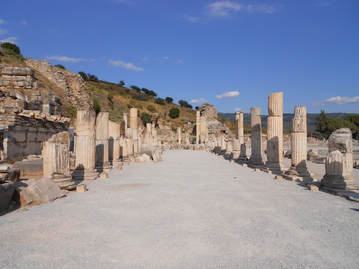 Basilica Stoa at Ephesus Ancient City Basilica Stoa at Ephesus Ancient City
This leveled area, part of the administrative area of Ephesus is one of 2 agoras (or markets) in the Ancient City of Ephesus.
Though not much remains of it at one time it was thought to be surrounded with a portico-like structure and adorned with various monuments.
Parts of 2 entrance gates can be seen in the southeast corner, straight across from the baths and the southwest corner, near the fountain of Laceanus Bassus on the corner of Temple of Domitian. Travelers who include Ephesus Museum in their Private Tours of Ephesus can see perfectly preserved Triton Statues from this particular fountain
The State Agora was surrounded by a Collonaded Alley from its 3 Sides, the 4th Side was left open because it was looking towardthe Temple of Domitian at Ephesus and they didn't want the Collonaded Section to Block the view of the Temple.
If you are looking to book a Guided Tour of Ephesus including The State Agora You can click here to Contact Us
From one of the Long Sides of the Agora, one was attached to the Senate Building tied up to it with a 2 storeyed Colonnaded Stoa. Today visitors can only see the columns from the lower tier of it.
The other Long side opposite the Senate was connected with the Main Cistern of the City where 6 different aqueduct lines would feed the City's Fountains and Baths. (Pollio, Hydreion)
In the center of the State Agora, you will see the foundations of what something was the Temple of ISIS, an Egyptian deity which may have been destroyed by Emperor Augustus. By taking a private tour of Ephesus archaeology museum you can see the Statue of Emperor Augustus which was excavated from this part of Ephesus City.
The Emperor may have ordered its destruction because of his dislike of the Egyptians. |
